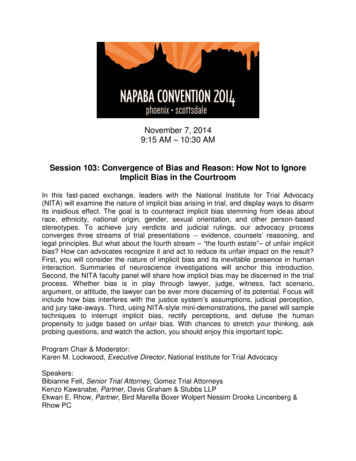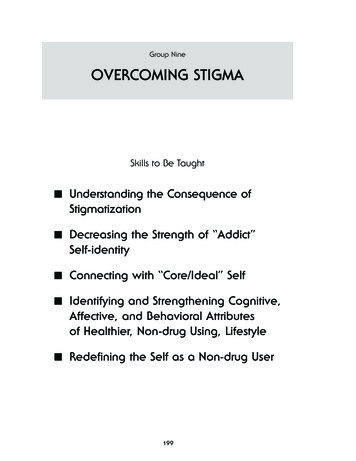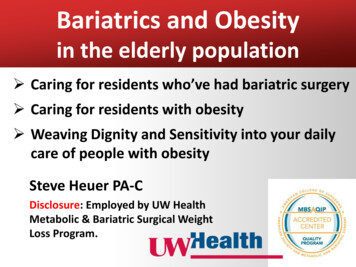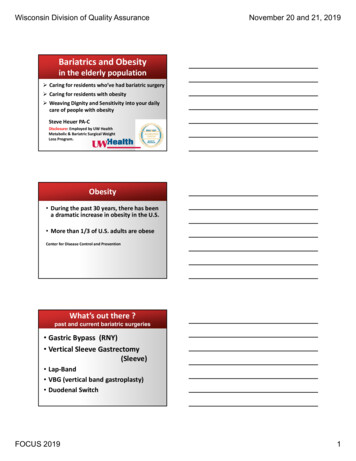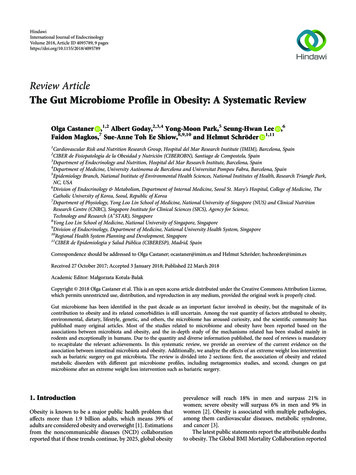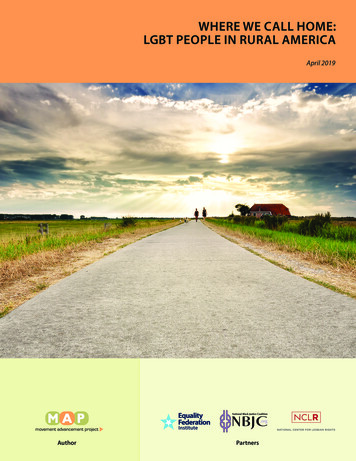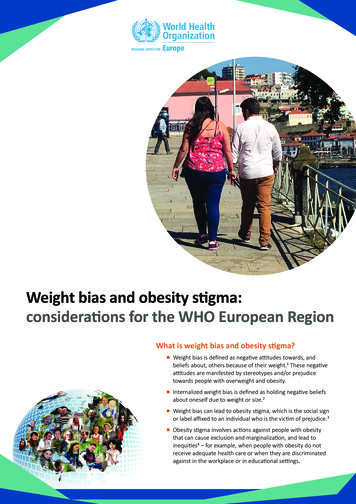
Transcription
Weight bias and obesity stigma:considerations for the WHO European RegionWhat is weight bias and obesity stigma? Weight bias is defined as negative attitudes towards, andbeliefs about, others because of their weight.1 These negativeattitudes are manifested by stereotypes and/or prejudicetowards people with overweight and obesity. Internalized weight bias is defined as holding negative beliefsabout oneself due to weight or size.2 Weight bias can lead to obesity stigma, which is the social signor label affixed to an individual who is the victim of prejudice.3 Obesity stigma involves actions against people with obesitythat can cause exclusion and marginalization, and lead toinequities4 – for example, when people with obesity do notreceive adequate health care or when they are discriminatedagainst in the workplace or in educational settings.
Where do people experience weight biasand stigma? Obesity stigma is ubiquitous. Detailed studies Popular narratives around obesity may contribute toweight bias by oversimplifying the causes of obesityand implying that easy solutions will lead to quickand sustainable results (“eat less, be more active”),thereby setting unrealistic expectations and maskingthe difficult challenges people with obesity can facein changing behaviour. Additionally, such narrativesoften focus discussion around individual behavioursand perceived failures, while neglecting to takeinto consideration important biological, social andenvironmental factors.14 The media often perpetuate stereotypical portrayalsof people living with obesity and reinforce the socialacceptability of weight bias.reporting on the situation in Europe are generallylacking, but a recent study from one country inwestern Europe found that 18.7% of people withobesity experienced stigma. For people with severeobesity, the figure was much higher – 38%.5 There is a lack of multinational studies comparingweight-biased attitudes, but a recent study involvingthe United States, Canada, Iceland and Australiaconcluded that levels of weight-biased attitudes aresimilar across countries.6 Individuals with obesity experience stigma fromeducators,7 employers,8 health professionals,9 themedia,10 and even from friends and family.11 Data from the Rudd Center for Food Policy andObesity indicate that:-- US studies show that 72% of media images and77% of videos stigmatize individuals with obesity.-- European studies show that media framing ofobesity places great emphasis on individualresponsibility and may contribute to a culture ofweight bias and stigma.11-- school-aged children with obesity experience a 63%higher chance of being bullied;-- Research shows that a very large percentageof discussions about obesity on social media,especially Twitter and Facebook, are of a fatshaming nature.15-- 54% of adults with obesity report being stigmatizedby co-workers;-- 69% of adults with obesity report experiences ofstigmatization from health care professionals.12 -- Shaming, harassing or criticizing people abouttheir weight and/or eating patterns is often usedin the media to motivate people to change theirbehaviour. Research shows that fat-shaming hasthe opposite effect.16 Fat-shaming causes stressand may lead to people overeating and avoidingphysical activity.17Although both men and women experience obesitystigma and pressures, women experience moreeating-related psychopathology, report experiencingmore obesity stigmatization, and internalize weightbias more than men.13What are the consequences of weight biasand stigma? Stigma is a fundamental cause of health inequalities-- poor body image and body dissatisfaction;-- low self-esteem and self-confidence;-- feelings of worthlessness and loneliness;and an added burden that affects people above andbeyond any impairments they may have.18 -- suicidal thoughts and acts;-- depression, anxiety and other psychologicaldisorders;Not unlike other forms of stigmatization (on thegrounds of race, class, ability, gender, sexualorientation, etc.), obesity stigma is associatedwith significant physiological and psychologicalconsequences, including increased depression andanxiety, disordered eating, and decreased selfesteem.19 Obesity stigma can also affect the quality of carefor patients with obesity, ultimately leading to poorhealth outcomes and increasing risk of mortality.20 Specifically, weight bias and obesity stigma have beenassociated with:-- maladaptive eating patterns;-- avoidance of physical activity;-- stress-induced pathophysiology;-- avoidance of medical care. Increasingly, evidence shows that individuals withobesity may internalize weight-biased attitudes,leading to self-directed shaming and stereotypesabout themselves. Weight-bias internalization canalso cause harm such as poor self-reported healthand health-related quality of life, binge-eating andmaladaptive health behaviours.21
What can be done to address weight biasand obesity stigma?The WHO Commission on Ending Childhood Obesityrecognized that obesity among children is associated withstigmatization and reduced educational attainment.25 TheCommission also affirmed that government and societyhave a moral responsibility to act on behalf of childrento reduce the health and social consequences of obesity.Failing to act on childhood obesity and to address obesitystigmatization and its associated morbidities will affectthe social and health capital of future generations andincrease inequity. In endorsing the Commission’s report andadopting its recommendations by means of a World HealthAssembly resolution, Member States have acknowledgedthat discrimination against children with obesity by healthcare professionals and others is unacceptable and thatstigmatization and bullying should be addressed.Public health objectiveTake a life-course approachand empower people.The WHO Regional Office for Europe can work with MemberStates in many different ways and through several policyframeworks to ensure that weight bias and obesity stigmaamong children and adults are addressed appropriately innational public health activities. This can be achieved, inparticular, through: research: collaborating with researchers and expertsto identify and validate approaches to reduce weightbias and obesity stigma;26 exchange: sharing knowledge and best practices atnational and local levels ;27 prioritization: exploring ways to elevate concernsabout weight bias and obesity stigma in variousarenas, including public policy, education and healthcare.28,29Some examples of how Member States might address theissue of weight bias and obesity stigma are outlined in thetable below.Specific action on weight bias and obesity stigma Monitor and respond to the impact of weight-based bullying among children andyoung people (e.g. through anti-bullying programmes and training for educationprofessionals). Assess some of the unintended consequences of current health-promotionstrategies on the lives and experiences of people with obesity. For example:-- Do programmes and services simplify obesity?-- Do programmes and services use stigmatizing language?-- Is there an opportunity to promote body positivity/confidence in children andyoung people in health promotion while also promoting healthier diets andphysical activity? Give a voice to children and young people with obesity and work with familiesto create family-centred school health approaches that strengthen children’sresilience and consider positive outcomes including but not limited to weight.30 Create new standards for the portrayal of individuals with obesity in the media andshift from use of imagery and language that depict people living with obesity in anegative light.31 Consider the following:-- avoiding photographs that place unnecessary emphasis on excess weight orthat isolate an individual’s body parts (e.g. images that disproportionately showabdomen or lower body; images that show bare midriff to emphasize excessweight);-- avoiding pictures that show individuals from the neck down (or with faceblocked) for anonymity (e.g. images that show individuals with their head cut outof the image);-- avoiding photographs that perpetuate a stereotype (e.g. eating junk food,engaging in sedentary behaviour) and do not share context with theaccompanying written content.32
Strengthen people-centredhealth systems and publichealth. Adopt people-first language in health systems and public health care services,such as a “patient or person with obesity” rather than “obese patient”. Engage people with obesity in the development of public health and primaryhealth care programmes and services. Address weight bias in primary health care services and develop health caremodels that support the needs of people with obesity. Apply integrated chronic care frameworks to improve patient experience andoutcomes in preventing and managing obesity. In addition:-- recognize that many patients with obesity have tried to lose weight repeatedly;-- consider that patients may have had negative experiences with healthprofessionals, and approach patients with sensitivity and empathy;-- emphasize the importance of realistic and sustainable behaviour change – focuson meaningful health gains and-- explore all possible causes of a presenting problem, and avoid assuming it is aresult of an individual’s weight status.Create supportivecommunities and healthyenvironments. Acknowledge the difficulty of achieving sustainable and significant weight loss. Promote mental health resilience and body positivity among children, youngpeople and adults with obesity. sensitize health professionals, educators and policy makers to the impact of weightbias and obesity stigma on health and well-being.Consider the unintended consequences of simplistic obesity narratives and addressall the factors (social, environmental) that drive obesity.33, 34Case exampleResearch shows that 47% of girls and 34% of boys with overweight report being victimized by family members.22When children and young people are bullied or victimized because of their weight by peers, family and friends, itcan trigger feelings of shame and lead to depression, low self-esteem, poor body image and even suicide. Shameand depression can lead children to avoid exercising or eating in public for fear of public humiliation. Children andyoung people with obesity can experience teasing, verbal threats and physical assaults (for instance, being spat on,having property stolen or damaged, or being humiliated in public). They can also experience social isolation by beingexcluded from school and social activities or being ignored by classmates.Weight-biased attitudes on the part of teachers can lead them to form lower expectations of students, which canlead to lower educational outcomes for children and young people with obesity.23 This, in turn, can affect children’slife chances and opportunities, and ultimately lead to social and health inequities.24 It is important to be awareof our own weight-biased attitudes and cautious when talking to children and young people about their weight.Parents can also advocate for their children with teachers and principals by expressing concerns and promotingawareness of weight bias in schools. Policies are needed to prevent weight-victimization in schools.AcknowledgementsThis brief was prepared for the WHO Regional Office for Europe by Ximena Ramos Salas , with additional input from JoJewell and João Breda. The technical review on issues relating to gender, equity and rights was provided by Åsa Nihlén andIsabel Yordi, also of the WHO Regional Office for Europe.
34.Andreyeva T, Puhl RM, Brownell KD. Changes in perceived weight discrimination among Americans, 1995–1996 through 2004–2006. Obesity2008;16(5):1129–34.Latner JD, Barile JP, Durso LE, O’Brien KS. Weight and health-related quality of life: the moderating role of weight discrimination and internalized weight bias.Eat Behav. 2014;15(4):586–90.Browne N. Weight bias, stigmatization, and bullying of obese youth. Bariatr Nurs Surg Patient Care 2012;7(3):107–15.Puhl RM. Weight stigmatization toward youth: a significant problem in need of societal solutions. Child Obes. 2011;7(5):359.Sikorski C, Spahlholz J, Hartlev M, Riedel-Heller S. Weight-based discrimination: an ubiquitary phenomenon? Int J Obes (Lond) 2016;40(2):333–7.Puhl RM, Latner JD, O’Brien K, Luedicke J, Danielsdottir S, Forhan M. A multinational examination of weight bias: predictors of anti-fat attitudes across fourcountries. Int J Obes (Lond) 2015;39(7):1166–73.Cameron E. Challenging “size matters” messages: an exploration of the experiences of critical obesity scholars in higher education. Can J Higher Education2016;46(2):111–26.Rudolph CW, Wells CL, Weller MD, Baltes BB. A meta-analysis of empirical studies of weight-based bias in the workplace. J Vocat Behav. 2009;74:1–10.Kirk SFL, Price SL, Penney TL, Rehman L, Lyons RF, Piccinini-Vallis H et al. Blame, shame, and lack of support: a multilevel study on obesity management. QualHealth Res. 2014;24(6):790–800.Brochu PM, Pearl RL, Puhl RM, Brownell KD. Do media portrayals of obesity influence support for weight-related medical policy? Health Psychol.2014;33(2):197–200.Puhl RM, Moss-Racusin CA, Schwartz MB, Brownell KD. Weight stigmatization and bias reduction: perspectives of overweight and obese adults. Health EducRes. 2008;23(2):347–58.Rudd Center for Food Policy and Obesity (http://www.uconnruddcenter.org).Boswell RG, White MA. Gender differences in weight bias internalisation and eating pathology in overweight individuals. Adv Eat Disord. 2015;3(3):259–68.Alberga AS, Russell-Mayhew S, von Ranson KM, McLaren L, Ramos Salas X, Sharma AM. Future research in weight bias: what next? Obesity2016;24(6):1207–9.Gunnars K. Science confirms: “fat shaming” just makes things worse. Healthline [website]. 20 September 2015 hings-worse, accessed 2 October 2017).Tomiyama AJ. Weight stigma is stressful: a review of evidence for the cyclic obesity/weight-based stigma model. Appetite 2014;82:8–15.Major B, Hunger JM, Bunyan DP, Miller CT. The ironic effects of weight stigma. J Exp Soc Psychol. 2014;51:74–80.Schvey N, Puhl RM, Brownell KD. The stress of stigma: exploring the effect of weight stigma on cortisol reactivity. Psychosom Med. 2014;76(2):156–62.Schvey NA, Puhl RM, Brownell KD. The impact of weight stigma on caloric consumption. Obesity 2011;19(10):1957–62.Hatzenbuehler ML, Phelan JC, Link BG. Stigma as a fundamental cause of population health inequalities. Am J Public Health 2013;103(5):813–21.Puhl RM, Heuer CA. The stigma of obesity: a review and update. Obesity 2009;17(5):941–64.Sutin AR, Stephan Y, Terracciano A. Weight discrimination and risk of mortality. Psychol Sci. 2015;26(11):1803–11.Kahan S, Puhl RM. The damaging effects of weight bias internalization. Obesity 2017;25(2):280–1.Puhl RM, Brownell KD. Confronting and coping with weight stigma: an investigation of overweight and obese adults. Obesity 2006;14(10):1802–15.Kenney EL, Gortmaker SL, Davison KK, Bryn Austin S. The academic penalty for gaining weight: a longitudinal, change-in-change analysis of BMI andperceived academic ability in middle school students. Int J Obes (Lond) 2015;39(9):1408–13.Link BG, Hatzenbuehler ML. Stigma as an unrecognized determinant of population health: research and policy implications. J Health Polit Policy Law2016;41(4):653–73.Report of the Commission on Ending Childhood Obesity (page 7). Geneva: World Health Organization; 2016 /9789241510066 eng.pdf, accessed 2 October 2017).Ramos Salas X. The ineffectiveness and unintended consequences of the public health war on obesity. Can J Public Health 2015;106(2):e79–81.Ramos Salas X, Cameron E, Estey L, Forhan M, Kirk SFL, Russell-Mayhew S et al. Addressing weight bias and discrimination: moving beyond raising awarenessto creating change. Obesity Reviews 2017.Forhan M, Ramos Salas X. Inequities in healthcare: a review of bias and discrimination in obesity treatment. Can J Diabetes 2013;37(3):205–9.Alberga AS, Pickering BJ, Alix Hayden K, Ball GD, Edwards A, Jelinski S et al. Weight bias reduction in health professionals: a systematic review. Clin Obes.2016;6(3):175–88.Bromfield PV. Childhood obesity: psychosocial outcomes and the role of weight bias and stigma. Educational Psychology in Practice 2009;25(3):193–209.Russell-Mayhew S, Ireland A, Klingle K. Barriers and facilitators to promoting health in schools: lessons learned from educational professionals. CanadianSchool Counselling Review 2016;1(1):49–55.Obesity photography guide. World Obesity Image Bank [website] (http://www.imagebank.worldobesity.org/guidelines, accessed 2 October 2017).Online image banks to draw from include: Canadian Obesity Network th); Rudd Center for Food Policyand Obesity (http://www.uconnruddcenter.org/video-library); and World Obesity Image Bank (http://www.imagebank.worldobesity.org).Ottawa Charter for Health Promotion. World Health Organization; 1986 evious/ottawa/en, accessed 2October 2017)Puhl RM, Heuer CA. Obesity stigma: important considerations for public health. Am J Public Health 2010;100(6):1019–28.World Health OrganizationRegional Office for EuropeUN City, Marmorvej 51, DK-2100 Copenhagen Ø, DenmarkTel: 45 45 33 70 00 Fax: 45 45 33 70 01Email: eucontact@who.intWebsite: www.euro.who.int
Weight bias and obesity stigma: considerations for the WHO European Region What is weight bias and obesity stigma? Weight bias is defined as negative attitudes towards, and beliefs about, ot



